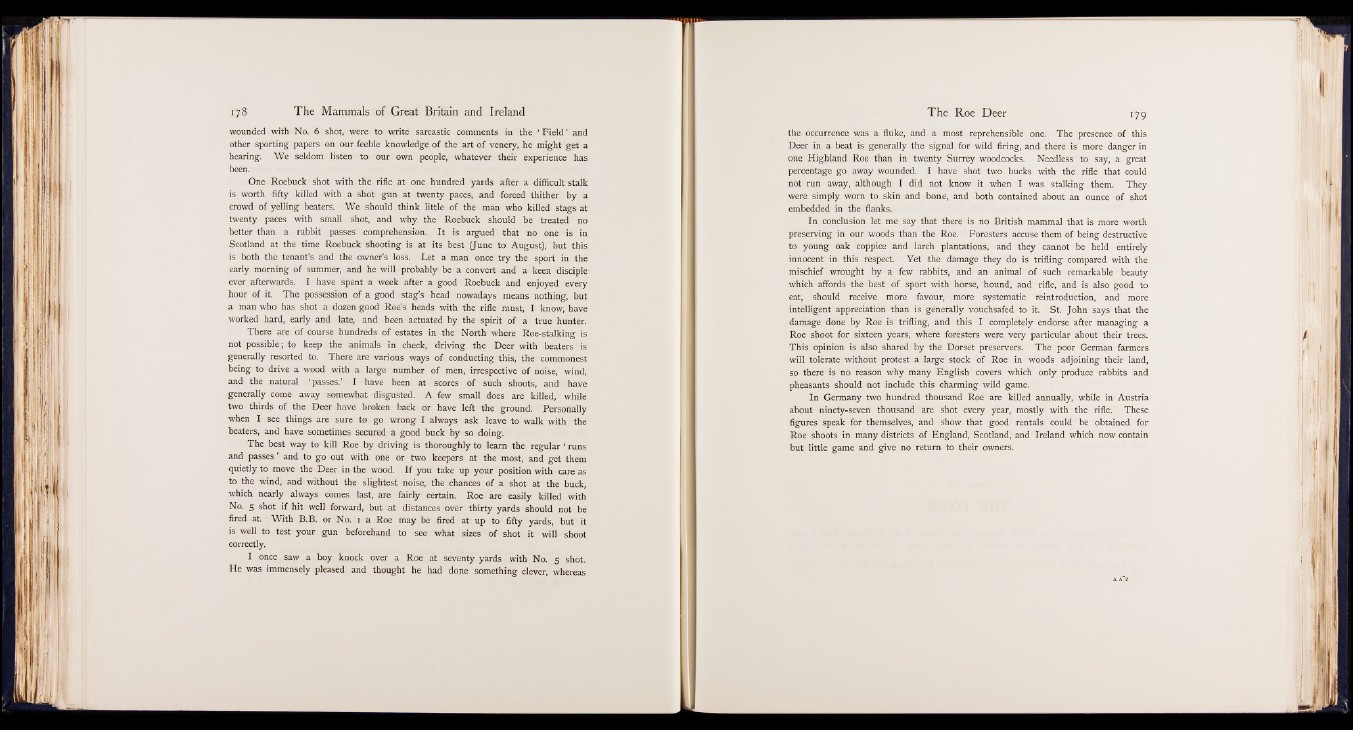
wounded with No. 6 shot, were to write sarcastic comments in the ‘ Field ’ and
other sporting papers on our feeble knowledge of the art of venery, he might get a
hearing. We seldom listen to our own people, whatever their experience has
been.
One Roebuck shot with the rifle at one hundred yards after a difficult stalk
is worth fifty killed with a shot gun at twenty paces, and forced thither by a
crowd of yelling beaters. We should think little of the man who killed stags at
twenty paces with small shot, and why the Roebuck should be treated no
better than a rabbit passes comprehension. It is argued that no one is in
Scotland at the time Roebuck shooting is at its best (June to August), but this
is both the tenant’s and the owner’s loss. Let a man once try the sport in the
early morning of summer, and he will probably be a convert and a keen disciple
ever afterwards. I have spent a week after a good Roebuck and enjoyed every
hour of it. The possession of a good stag’s head nowadays means nothing, but
a man who has shot a dozen good Roe’s heads with the rifle must, I know, have
worked hard, early and late, and been actuated by the spirit of a true hunter.
There are of course hundreds of estates in the North where Roe-stalking is
not possible; to keep the animals in check, driving the Deer with beaters is
generally resorted to. There are various ways of conducting this, the commonest
being to drive a wood with a large number of men, irrespective of noise, wind,
and the natural ‘ passes.’ I have been at scores of such shoots, and have
generally come away somewhat disgusted. A few small does are killed, while
two thirds of the Deer have broken back or have left the ground. Personally
when I see things are sure to go wrong I always ask leave to walk with the
beaters, and have sometimes secured a good buck by so doing.
The best way to kill Roe by driving is thoroughly to learn the regular ‘ runs
and passes ’ and to go out with one or two keepers at the most, and get them
quietly to move the Deer in the wood. I f you take up your position with care as
to the wind, and without the slightest noise, the chances of a shot at the buck,
which nearly always comes last, are fairly certain. Roe are easily killed with
No. 5 shot if hit well forward, but at distances over thirty yards should not be
fired at. With B.B. or No. i a Roe may be fired at up to fifty yards, but it
is well to test your gun beforehand to see what sizes of shot it will shoot
correctly.
I once saw a boy knock over a Roe at seventy yards with No. 5 shot.
He was immensely pleased and thought he had done something clever, whereas
the occurrence was a fluke, and a most reprehensible one. The presence of this
Deer in a beat is generally the signal for wild firing, and there is more danger in
one Highland Roe than in twenty Surrey woodcocks. Needless to say, a great
percentage go away wounded. I have shot two bucks with the rifle that could
not run away, although I did not know it when I was stalking them. They
were simply worn to skin and bone, and both contained about an ounce of shot
embedded in the flanks.
In conclusion let me say that there is no British mammal that is more worth
preserving in our woods than the Roe. Foresters accuse them of being destructive
to young oak coppice and larch plantations, and they cannot be held entirely
innocent in this respect. Yet the damage they do is trifling compared with the
mischief wrought by a few rabbits, and an animal of such remarkable beauty
which affords the best of sport with horse, hound, and rifle, and is also good to
eat, should receive more favour, more systematic réintroduction, and more
intelligent appreciation than is generally vouchsafed to it. St. John says that the
damage done by Roe is trifling, and this I completely endorse after managing a
Roe shoot for sixteen years, where foresters were very particular about their trees.
This opinion is also shared by the Dorset preservers. The poor German farmers
will tolerate without protest a large stock of Roe in woods adjoining their land,
so there is no reason why many English covers which only produce rabbits and
pheasants should not include this charming wild game.
In Germany two hundred thousand Roe are killed annually, while in Austria
about ninety-seven thousand are shot every year, mostly with the rifle. These
figures speak for themselves, and show that good rentals could be obtained for
Roe shoots in many districts of England, Scotland, and Ireland which now contain
but little game and give no return to their owners.